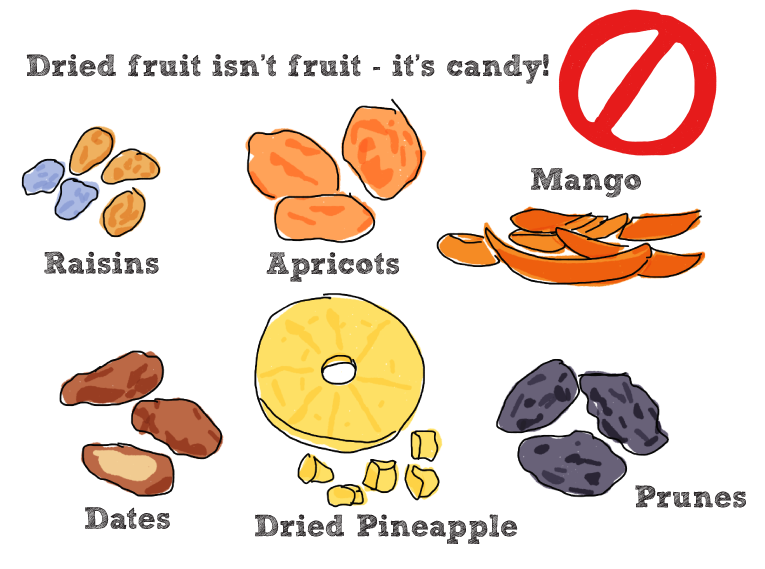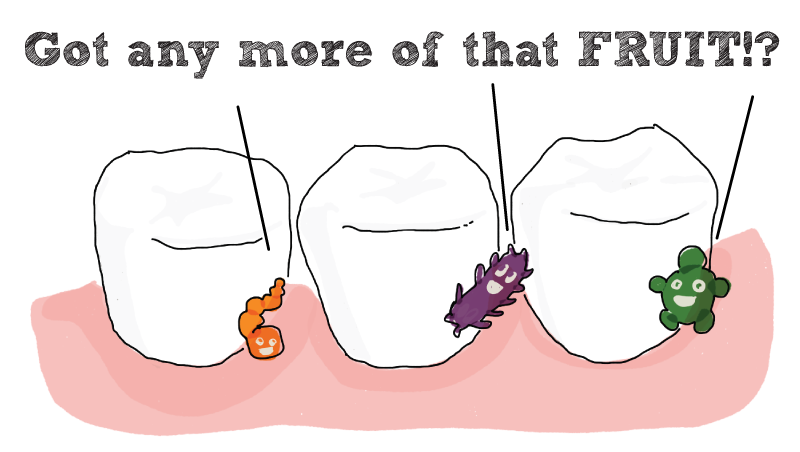In Defense of Fruit
Diet trends come and go. In the course of a year one particular food will come into fashion, while another falls out of favor.
Over the past few years we’ve seen protein and fat become the focus of many popular plans, while sugar and carbs are the new public enemy number one. The popular Keto Diet is the main driver of this new trend.
A keto-approved meal — steak with a quarter stick of butter. Keto dieters aim for calories coming about 70% from fat, 25% from protein, and only 5% from carbs. This means fruit and grains are off the table, with only a few vegetables being low enough in carbohydrates to make the cut.
If avoiding carbs and sugar means people are eating fewer deep dish pizza and cupcakes, that’s a positive thing. But one of the unfortunate casualties of the carb-and-sugar wars is good old-fashioned fruit.
As Keto has gained steam, we see more and more trainees coming to us with a strong aversion to eating fruit. When you’ve been told that any and all sugar is bad, eating something that’s as sweet and sugary as an apple, banana, orange or melon seems like an indulgent, out-of-bounds choice.
This is a shame, because fruit is an incredibly useful item to have in your nutritional toolkit. In this article we’ll give you the Kenzai perspective on the wonders of fruit, and tell you how to use it to get the best results. Sweet!
NOT AS MUCH SUGAR AS YOU THINK
If you look at the nutritional information for fruit, you’ll see that nearly all of its caloric load comes from sugar in the form of fructose. Fructose? Yikes! Sounds like a lot of bad sugar!
But let’s look more closely. Here’s the sugar content for six everyday fruits. To make the comparisons accurate we're using a universal 100 gram serving (this would roughly fill a small bowl).
We chose these six examples to show the range that you’ll encounter in the world of fruit. Strawberries are among the least sugary, and grapes among the most. If you’re eating a good variety of fruit during the week, we can assume the following average:
100 GRAMS OF FRUIT = 10 GRAMS OF SUGAR (40 CALORIES)
(You’ll note this lines up with the sugar and caloric load of an apple. It’s one reason the mighty apple is a great benchmark for fruit, and should be a part of your regular rotation)
You might be wondering, is 10 grams of sugar per 100 grams a lot?
Let’s compare that to some other items that people often reach for instead of fresh fruit.
In every case, you’re going to be consuming less sugar going with the fresh fruit choice. It's not a bad deal at all, you get to enjoy a sweet, filling, satisfying food at a quarter of the sugar and caloric content.
As a doctor friend of ours put it when discussing the new fear of fruit, “In 30 years I’ve never seen anyone get fat because they ate too much fruit.”
But that’s just the START of the good news.
NOT EMPTY CALORIES
For your 40 average Calories per fruit serving, you don’t just get some sugar in your system. Fruit is dense with vitamins and minerals which your body uses to smoothly complete its daily functions. Vitamins and minerals aren’t used for energy, but as helper molecules for nearly every physiological function, including digestion, metabolism, immune response, and tissue repair.
When you notice someone is “glowing” with health, what you’re seeing is a body that’s working with high efficiency, getting the most vitality possible out of its food and exercise inputs. When hundreds of small processes are going right deep in the body, the results work themselves from the inside out and add up to a person that exudes healthy energy. You don’t get this effect with a high protein and fat diet, and certainly not with a diet heavy in processed foods.
Fruits are nature’s multivitamins, the way your body craves them, as part of complex organic structures, not in concentrated pill-form.
(To this day people still have a strong, almost reverent devotion to vitamin supplements. If you’re one of them please give this Scientific American article a read and learn why, for healthy people, vitamins are a net negative for both your wellness and your budget.)
DON'T FORGET FIBER
Dietary fiber describes those parts of fruits and vegetables which our bodies can’t break apart for energy. Instead, these fibers move through your stomach and intestines more-or-less intact.
Fiber is criminally underrated. Most people think of it as a punchline, something only the elderly need to worry about. Dietary fiber is a key part of digestion, as all those little fibers help move food through your digestive tract, and form the matrix around which your waste is excreted smoothly.
But beyond that, we’re learning more and more that a diet with plenty of fiber is an important part of maintaining a healthy gut biome. Even if YOU can’t digest fiber, there are billions of bacteria in your intestines which can, and make good use of it, producing helpful nutrition byproducts along the way. A well-fed bacterial ecosystem improves wellness outcomes in ways we’re just starting to understand
THE ENERGY BRIDGE
Consuming more fruit is great, but we’ve found that when used in a specific way, it becomes a huge boost to your quality of life and wellness outcomes. We call this the “energy bridge.”
Most people have 3 meals a day, perhaps 2 if they skip breakfast, with 5-7 hours between those meals. The body is of course, quite capable of going 5-7 hours without food. But as your blood sugar drops between meals, your energy management systems are forced to switch to other modes to keep you supplied with fuel to move around, use your organs, and think with your glucose-hungry brain.
This means that your body will switch over to fat burning pathways (or more rarely, muscle burning pathways) to create the glucose you need. This is what gives the Keto diet it’s name. Ketogenesis is the process of converting fat to glucose, and why fruit and other carbs are forbidden for those following that diet path.
But burning fat is good right? The problem is that the process of switching over to the alternate energy production mode is energy-intensive and inefficient. It’s as if you were driving a car on regular gas, then made a pitstop to change the entire engine to use diesel gas. The result is that between-meal sluggishness you perceive as the morning or afternoon slump. (Keto enthusiasts try to counter this negative effect by staying completely in ketosis all the time, which means no carbs, no sweets, no root vegetables, and no fruit — ever. This is a lot to take away from a person’s eating choices and why we don’t recommend Keto. It's so restrictive that quality of life suffers.)
Many people combat the midday or mid-afternoon lull with a carby, sugary snack. This is where cafe display cases and vending machines make their money. But when you hit a sugar-starved body with a big, easily-digested refined-sugar product, it spikes your blood sugar precipitously, leading to an overactive insulin response. This spike then causes a sugar crash 30-45 minutes later as all that extra insulin pulls too much sugar from the blood. This throws you into yet another lull which sends you lurching towards an overly-large lunch or dinner. Many people unknowingly spend all week on this rollercoaster, and wonder why they feel so run-down all the time.
If only there was a kind of food which contained a low dose of sugar with some kind of time-release mechanism to avoid sugar crashes...
Aha! Fruit fits that profile perfectly!
Fruit gives you a mild serving of sugar, diluted in a 90/10 ratio with water so that it fills you up and satiates. And because much of that sugar is bound up in fiber, your stomach takes time to digest it, releasing it slowly over the course of 30-45 minutes. This tracks smoothly with your insulin response (no surprise since the insulin response evolved in a context of hunter-gatherer fruit-eating) and you don’t experience sugar crashes.
The result is that fruit becomes an energy bridge that keeps your blood sugar stable between larger meals. As a result you feel less lethargic, more focused, and tend to eat less at lunch and dinner.
Fruit is great any time of day, but if you deploy it mid-morning and mid-afternoon, you’ll see terrific results. Don’t take our word for it, try it for a week and feel it working in your own physiology.
All of these fantastic effects, from one of the cheapest areas of the supermarket, available in every country around the world. Fabulous, flexible, filling fruit!
FRUITY FINE PRINT
If you’re looking to raise your fruit game, there are a few things to be careful of.
• Make a truce with juice
All that great fiber which fills you up, creates time-release sugars, and feeds your happy gut flora? Well, if you’re drinking juice, you’re letting a blender do all the work your stomach was supposed to do, and losing that important benefit.
Juice also has the effect of concentrating fruit. A bottle of apple juice, for example, has about 2.5 apples worth of sugar. Think how you’d be feeling if you ate two and a half apples in one sitting. You’d be stuffed, and yet you can consume the equivalent sugar of all that fruit in just a few minutes of sipping juice. And this doesn’t even get into added sugar, which many juices include to mask fruit’s bitter undertones.
Fruit is good. Fruit juice is bad. Watch out for this with your kids too, whose juice boxes often contain as much sugar as a soda or candy bar.
• Give dried fruit the boot
The same applies to dehydrated fruits. Through the dehydration process you lose water and fiber, ending up with just the sugar portion of fruit (and often more sugar is added on top of that). These snacks have a closer nutritional profile to candy than to the fresh fruits they’re made from. And because they have zero water content, they don’t fill you up, making overeating more likely.
• Tooth decay
Remember how we talked about how the bacteria in your gut love the fiber of fresh fruit? Well, the bacteria in your mouth also love it, and because of fruit’s watery, fibrous nature, it’s all too easy to have some get stuck in between your teeth, where the bacteria will view it as a buffet line, eating and excreting acid which leads to tooth decay and dental caries.
Fortunately, the solution to this is just a toothbrush away. If you’re eating fruit in the middle of the day, do your best to get a midday brush in as well, and floss in the evenings to make sure all those pesky sugary fibers don’t spend the night in your teeth.
DON'T JUST READ THIS AND NOD YOUR HEAD WISELY, TRY IT!
As surely as the world turns, healthy eating trends will come and go. Hopefully, fruit makes a comeback soon, and we arrive at a more balanced place in our relationship with sugar. Not all sugar is evil, athletes have known for centuries that a serving of fruit at the right time will boost performance, aid recovery, and keep your body running smoothly through the rigors of life. Get some of that for yourself!
Fill a bowl with a colorful bouquet of fruit this week and try eating it in the mid-morning and mid-afternoon. Take notes on how it changes your mental and physical sense of well-being. We’re willing to bet you’ll come out of that week feeling great, and respecting the power of fruit.










